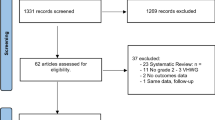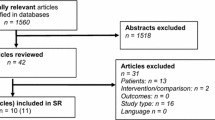Abstract
There is no consensus on the ideal location for mesh placement in open ventral hernia repair (OVHR). We aim to identify the mesh location associated with the lowest rate of recurrence following OVHR using a systematic review and meta-analysis. A search was performed for studies comparing at least two of four locations for mesh placement during OVHR (onlay, inlay, sublay, and underlay). Outcomes assessed were hernia recurrence and surgical site infection (SSI). Pairwise meta-analysis was performed to compare all direct treatment of mesh locations. A multiple treatment meta-analysis was performed to compare all mesh locations in the Bayesian framework. Sensitivity analyses were planned for the following: studies with a low risk of bias, incisional hernias, by hernia size, and by mesh type (synthetic or biologic). Twenty-one studies were identified (n = 5,891). Sublay placement of mesh was associated with the lowest risk for recurrence [OR 0.218 (95 % CI 0.06–0.47)] and was the best of the four treatment modalities assessed [Prob (best) = 94.2 %]. Sublay was also associated with the lowest risk for SSI [OR 0.449 (95 % CI 0.12–1.16)] and was the best of the 4 treatment modalities assessed [Prob (best) = 77.3 %]. When only assessing studies at low risk of bias, of incisional hernias, and using synthetic mesh, the probability that sublay had the lowest rate of recurrence and SSI was high. Sublay mesh location has lower complication rates than other mesh locations. While additional randomized controlled trials are needed to validate these findings, this network meta-analysis suggests the probability of sublay being the best location for mesh placement is high.



Similar content being viewed by others
References
Luijendijk RW et al (2000) A comparison of suture repair with mesh repair for incisional hernia. N Engl J Med 343(6):392–398
Burger JW et al (2004) Long-term follow-up of a randomized controlled trial of suture versus mesh repair of incisional hernia. Ann Surg 240(4):578–583
Nguyen MT et al (2014) Comparison of outcomes of synthetic mesh vs suture repair of elective primary ventral herniorrhaphy: a systematic review and meta-analysis. JAMA Surg 149(5):415–421
Berger RL et al (2014) Suture versus preperitoneal polypropylene mesh for elective umbilical hernia repairs. J Surg Res 192(2):426–431
Albino FP et al (2013) Does mesh location matter in abdominal wall reconstruction? A systematic review of the literature and a summary of recommendations. Plast Reconstr Surg 132(5):1295–1304
Snyder CW et al (2011) Effect of mesh type and position on subsequent abdominal operations after incisional hernia repair. J Am Coll Surg 212(4):496–502
Berger RL et al (2013) Development and validation of a risk-stratification score for surgical site occurrence and surgical site infection after open ventral hernia repair. J Am Coll Surg 217(6):974–982
Novitsky YW et al (2007) Comparative evaluation of adhesion formation, strength of ingrowth, and textile properties of prosthetic meshes after long-term intra-abdominal implantation in a rabbit. J Surg Res 140(1):6–11
Robinson TN et al (2005) Major mesh-related complications following hernia repair: events reported to the Food and Drug Administration. Surg Endosc 19(12):1556–1560
Losanoff JE, Richman BW, Jones JW (2002) Entero-colocutaneous fistula: a late consequence of polypropylene mesh abdominal wall repair: case report and review of the literature. Hernia 6(3):144–147
Miller K, Junger W (1997) Ileocutaneous fistula formation following laparoscopic polypropylene mesh hernia repair. Surg Endosc 11(7):772–773
Cuccurullo D et al (2013) Laparoscopic ventral incisional hernia repair: evidence-based guidelines of the first Italian Consensus Conference. Hernia 17(5):557–566
Silecchia G et al (2015) Laparoscopic ventral/incisional hernia repair: updated guidelines from the EAES and EHS endorsed consensus development conference. Surg Endosc 29:2463–2484
Moher D et al (2009) Preferred reporting items for systematic reviews and meta-analyses: the PRISMA statement. J Clin Epidemiol 62(10):1006–1012
Slim K et al (2003) Methodological index for non-randomized studies (minors): development and validation of a new instrument. ANZ J Surg 73(9):712–716
Kissane NA, Itani KM (2012) A decade of ventral incisional hernia repairs with biologic acellular dermal matrix: what have we learned? Plast Reconstr Surg 130(5 Suppl 2):194S–202S
Jansen JP et al (2011) Interpreting indirect treatment comparisons and network meta-analysis for health-care decision making: report of the ISPOR task force on indirect treatment comparisons good research practices: part 1. Value Health 14(4):417–428
Hoaglin DC et al (2011) Conducting indirect-treatment-comparison and network-meta-analysis studies: report of the ISPOR task force on indirect treatment comparisons good research practices: part 2. Value Health 14(4):429–437
Gelman A, Rubin DB (1996) Markov chain Monte Carlo methods in biostatistics. Stat Methods Med Res 5(4):339–355
Salanti G, Marinho V, Higgins JP (2009) A case study of multiple-treatments meta-analysis demonstrates that covariates should be considered. J Clin Epidemiol 62(8):857–864
Vinuela EF et al (2012) Laparoscopic versus open distal gastrectomy for gastric cancer: a meta-analysis of randomized controlled trials and high-quality nonrandomized studies. Ann Surg 255(3):446–456
Afifi RY (2005) A prospective study between two different techniques for the repair of a large recurrent ventral hernia: a double mesh intraperitoneal repair versus onlay mesh repair. Hernia 9(4):310–315
Weber G, Baracs J, Horvath OP (2010) [“Onlay” mesh provides significantly better results than “sublay” reconstruction. Prospective randomized multicenter study of abdominal wall reconstruction with sutures only, or with surgical mesh-results of a five-years follow-up]. Magy Seb 63(5):302–311
Venclauskas L, Maleckas A, Kiudelis M (2010) One-year follow-up after incisional hernia treatment: results of a prospective randomized study. Hernia 14(6):575–582
Deerenberg EB et al (2015) A systematic review of the surgical treatment of large incisional hernia. Hernia 19(1):89–101
Eriksson A, Rosenberg J, Bisgaard T (2014) Surgical treatment for giant incisional hernia: a qualitative systematic review. Hernia 18(1):31–38
Guerin G, Turquier F (2013) Impact of the defect size, the mesh overlap and the fixation depth on ventral hernia repairs: a combined experimental and numerical approach. Hernia 17(5):647–655
Mills EJ, Thorlund K, Ioannidis JP (2013) Demystifying trial networks and network meta-analysis. BMJ 346:f2914
Brozek JL et al (2009) Grading quality of evidence and strength of recommendations in clinical practice guidelines. Part 1 of 3. An overview of the GRADE approach and grading quality of evidence about interventions. Allergy 64(5):669–677
Disclosures
Mike K. Liang this work was supported by the Center for Clinical and Translational Sciences, which is funded by National Institutes of Health Clinical and Translational Award UL1 TR000371 and KL2 TR000370 from the National Center for Advancing Translational Sciences. The National Center for Research Resources or the National Institutes of Health was not responsible for the design and conduct of the study; collection, management, analysis, and interpretation of the data; preparation, review, or approval of the manuscript; or decision to submit the manuscript for publication.
Author information
Authors and Affiliations
Corresponding author
Rights and permissions
About this article
Cite this article
Holihan, J.L., Nguyen, D.H., Nguyen, M.T. et al. Mesh Location in Open Ventral Hernia Repair: A Systematic Review and Network Meta-analysis. World J Surg 40, 89–99 (2016). https://doi.org/10.1007/s00268-015-3252-9
Published:
Issue Date:
DOI: https://doi.org/10.1007/s00268-015-3252-9




